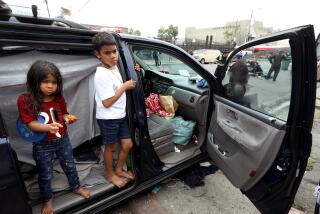Bangkok’s Slums Harboring Hopes as Well as Squalor, Violence, Despair
- Share via
BANGKOK — To most outsiders, Bangkok’s largest slum, Klong Toey, is a repulsive maze of densely packed shacks tottering over a marsh awash in garbage and other reeking waste.
“I’ve seen a lot of things in my slum,” 12-year-old Suree Lokavit wrote recently. “Some people steal and others brawl. They inject heroin, sniff glue thinner and smoke marijuana. Many parents don’t have money to send their children to school, and many children simply don’t have parents.”
Researchers bear out her observations.
Nearly 70% of the slum children do not live with their natural parents, and along with a drug epidemic, the slum’s 60,000 inhabitants face devastating fires, chemical pollution, eviction and a new scourge--AIDS.
But Suree and many of her schoolmates graphically highlight the good people, the big-heartedness amid the violence and poverty of Klong Toey.
In interviews and school essays, the youngsters told of a warm sense of belonging to a community not unlike the rural villages from which their parents migrated in search of a better life.
“People of high status live in condominiums. Most poor people live in slums. I live in a slum,” wrote fifth-grader Rungroj Sriruang, whose father is a bus driver. “I walk to school through stinking garbage and polluted air, but I’m used to it now. It’s been that way since I was a small boy.
“Some people look down on slums as low class,” his essay concluded. “But when there is free time, we will come together to share real happiness and fun. Even with the filth and the bad people, our slum seems like heaven then.”
After Sirinath Phumsongwon’s home burned to the ground three years ago, she and her family moved next to the pig slaughterhouse in the slum. This neighborhood is said to have Klong Toey’s toughest kids, the vilest stench and the highest rates of pulmonary disease. Flies swarm around pools of congealed blood and discarded entrails from the slaughterhouse.
Earlier, residents had to wade through the refuse to get to their homes when the nearby Chao Phraya River rose to inundate the marshland.
But the neighborhood decided to take action, Sirinath explained. Wooden planks, nails and tools were obtained, and families worked together to build a walkway above the fetid water, one that now connects their patchwork of stilt-raised shanties.
“I would like to name this bridge the ‘Bridge of Generous, Neighborly Spirit,’ ” she said.
Meeting Suphawan Ngencharoen was a surprise after reading her essay, which starkly described unhappiness in her family and around her: AIDS spreading from the shared needles of addicts; the emaciated frames, purplish lips and lost stares of heroin users.
The bright, willowy 12-year-old girl was dressed in clean, neatly pressed clothes. Her manners and choice of words were impeccably polite. Her eyes sparkled.
When asked about the most distressing moment of her life, she described running out of her house at night as chemical fumes swirled into the slum from a nearby explosion and vomiting in an open field.
“The happiest moments of my life are when my daddy and mama don’t fight and we live together happily as a family,” she said.
With family turmoil common, Suphawan and her companions seem to find a womb-like comfort in their school, Samaggi Songkroh, which many of its more than 300 pupils describe as their second home. The primary school for slum children is largely subsidized by the Thai government, aided by the Roman Catholic Church and run by Sister Somsri, a nun who personally administers a whacking to errant students after calling in their parents.
The children arrive at 6 a.m. and often do not return home until dark. After classes, they play musical instruments and engage in sports.
“We can never get rid of them,” Father Joseph H. Maier said jokingly. “Some even sleep in the classrooms. And we get all sorts of tearful sessions: ‘Why can’t my mommy be like my teacher and not beat and curse me?’ ”
“Father Joe,” as everyone calls the 49-year-old priest, is another source of hope and help in Klong Toey, especially for the young who are the focus of many of his projects.
After 15 years in the slum, the street-smart and compassionate American knows hundreds by name, life history and prison record. He comforts prostitutes, puts down thugs with a few well-chosen words and cajoles parents into sending their children to school. Now he is working on a father who sends his armless, 7-year-old son into the streets, where he can make more than 100 baht ($4) a day begging.
Another beacon of the better life is Prateep Ungsongtham, known as the “Slum Angel of Bangkok.” An unassuming, 37-year-old woman who had the chance to move out of the slums, she stayed to start schools and fight the eviction of squatters, who she charges are victims of mysterious slum fires, crooked deals and gangster harassment.
Concrete Tenements
She and Father Joe maintain that there is less alienation and a more village-like atmosphere in Klong Toey’s ramshackle squalor than in the massive concrete tenements to which government officials would like the slum dwellers relocated.
“At four or five in the morning darkness, the adults of Klong Toey leave for work,” wrote Kanitha Thithama.
Many labor on construction sites, their 75 baht ($3) daily wage enabling entrepreneurs to profitably fill Bangkok’s skyline with office towers, condominiums and shopping centers.
There is not much free time. Fathers return late, and mothers frequently supplement incomes by crafting artificial flowers and shopping baskets or collecting used plastic bags for recycling.
Kanitha looks forward to the block parties at New Year’s and to Mother’s Day and Father’s Day, when community leaders strictly admonish everyone not to throw out trash “so our community is clean on at least those days of the year.”
More to Read
Sign up for Essential California
The most important California stories and recommendations in your inbox every morning.
You may occasionally receive promotional content from the Los Angeles Times.










